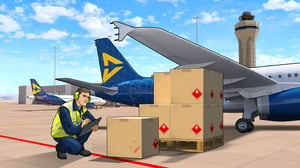Here, at Scandlearn we know that safety is paramount. To help protect everyone, from passengers to pilots, we must adhere to all regulations. The aviation industry faces many challenges on a daily basis so training aviation staff competently is what we strive to do. Today, we’re going to take a look at one of the many courses that Scandlearn provides, Dangerous Goods (DGR) – Carry.
What are Dangerous Goods?
We can define dangerous goods as articles or substances that can present a risk to health and safety. These risks can result in harm or injury to a person, to property or to the environment. Scandlearn’s dangerous goods training covers the lawfully required procedures put in place by the relevant authorities. We follow these procedures to minimise any risk posed to those involved in the handling and transportation process. This, in turn, helps to safeguard the general public and your business. Safer practices lead to fewer incidents and accidents.
Training is not only a legal requirement but it also provides your crew with invaluable information on how to run a safe, working environment for all. Each role has its own specific procedures to carry out within the system, all as important as each other. This means that ground crew will have different duties to perform in comparison with cabin crew etc. Working together, you reduce the chances of chemical leaks or explosions occurring mid-flight. Dangerous goods can cause a multitude of problems, sometimes FATAL, so preventable practices need to be in place before exposing staff to the dangers. For this reason, any new staff members must undertake compulsory training. They will also have to take refresher courses to keep their skills up to date every two years as common practice.
There are many reasons why dangerous goods training is necessary. The governing bodies within the industry have recognised that training staff in how to deal with dangerous goods is the best way to improve safety. A high percentage of accidents involving such goods are down to human error. That’s a good reason to raise awareness and teach sound practices.
Getting compliance with the regulations
Our course closely follows the EASA regulations but is also suitable for those who comply with other authorities and standards. Namely the ICAO-TI and IATA-DGR. With companies being able to sell their products all over the world, they may need to deliver far and wide. Shipping their cargo by air is necessary. Some packages will be safe and need no special attention. However, others could pose more of a safety risk once in the air.
A package containing soft toys, for example, will need less scrutiny than one full of lithium batteries. The workforce needs to keep this in mind when they process the different types of goods. Scandlearn’s Dangerous Goods (Carry) course will show you how this process works from start to finish. We explain why we must have these safety measures in place and how they comply with the relevant aviation laws.
Preparation is key
You MUST prepare your employees for the worst-case scenario. Give them knowledge of how to handle such situations if a problem occurs. Training your staff how to deal with eventualities, such as a chemical spillage, is far better for them to learn beforehand. As opposed to having to cope with a real-time incident that they have never seen before. This knowledge could be the difference in keeping the situation under control. Keeping workers safe rather than causing chaos and a possible fatality.
Staff should, indeed, take training very seriously. There’s a lot for personnel to learn, especially if they are new to the job. But, by the end of our course, they will learn how to handle each category of dangerous goods. Depending on their individual role, your crew will gain an understanding of processes such as how to implement regulations and how to classify goods etc. They will learn to identify emergency situations and how to prevent emergencies from happening in the first place, amongst other things. Prevention is, after all, better than the cure.
If you want to train your staff to the highest standards then choose Scandlearn. Have a look for yourself at what we can offer by hitting the link. Dangerous Goods (DGR) Carry. Management can assess the strengths and weaknesses of staff and help to improve skills that are lacking. This ensures that each member of staff gains the understanding that they need to fulfil their role. It’s a lawful requirement to retain all relevant documentation. This information can also help improve training for each individual. Concentrating on what skills they need to address will ensure they’re able to handle the process and, ultimately, strengthening the procedures already in place.
Why we need to train in Dangerous Goods
You must train all staff that work within the handling chain. It doesn’t matter how small or large their role is, they have to be familiar with dangerous goods training. Every link in the chain must be aware of their responsibilities as well as their legal requirements. Personnel must be aware, from accepting cargo through to storage. They must know the perils involved in the event of handling and storing dangerous goods incorrectly.
Scandlearn’s Dangerous Goods Carry training ensures staff understand their own responsibilities and shows them the safest way to go about their duties. Furthermore, the training provided encompasses the subjects of general awareness training. As well as safety training, job or function-specific training and security awareness training. Any person employed whose job involves coming into contact with dangerous goods needs to be qualified. They must be competent to undertake their roles within the team. This creates a safer, and more harmonious, working environment for all. Take a look at the course for yourself by following the link Dangerous Goods Training Carry.
It’s important that you leave no stone unturned when it comes to handling dangerous goods. You should follow regulations to the letter at all times. This will ensure that your staff are working to the highest standards. It also averts any preventable accidents or incidents from happening in your workplace.
Get the correct compliance in Dangerous Goods (DGR) Training
At Scandlearn, our Dangerous Goods (Carry) covers everything that you possibly need to train your staff competently and efficiently. You are giving them the skills that the EASA, ICAO-TI and IATA-DGR demand in their regulations. Scandlearn offers three variations of DGR.

